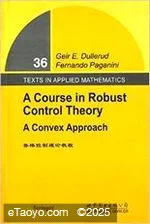
《鲁棒控制理论教程(英文)》主要介绍现代鲁棒控制的基本理论与应用成果,介绍有关基础知识,包括数学基础、稳定性、有界性和收敛性的基本定理、具有不确定性的系统的描述方法以及鲁棒稳定与鲁棒性能准则的条件;介绍鲁棒控制的理论成果,首先介绍了H∞控制理论;然后介绍了约束系统的鲁棒镇定和鲁棒H∞设计方法,最后阐述了不确定时滞系统的鲁棒镇定问题的最新研究成果及非线性鲁棒控制;最后分别介绍上述理论成果在机械系统和网络控制系统等系统中的设计实例。
编辑推荐
读者对象:《鲁棒控制理论教程(英文)》可以作为自动控制和电气工程专业的高年级本科生、研究生教材,也可供从事相关专业的科研人员和工程技术人员参考。
作者简介
作者:(美国)G.E.杜拉德(Geir E.Dullerud)
目录
Series Preface
Preface
Figures
0 Introduction
0.1 System representations
0.1.1 Block diagrams
0.1.2 Nonlinear equations and linear decompositions
0.2 R,obust control problems and uncertainty
0.2.1 Stabilization
0.2.2 Disturbances and commands
0.2.3 Unmodeled dynamics
Notes and references
1 Preliminaries in Finite Dimensional Space
1.1 Linear spaces and mappings
1.1.1 Vector spaces
1.1.2 Subspaces
1.1.3 Bases, spans, and linear independence
1.1.4 Mappings and matrix representations
1.1.5 Change of basis and invariance
1.2 Subsets and convexity
1.2.1 Some basic topology
1.2.2 Convexsets
1.3 Matrixtheory
1.3.1 Eigenvalues and Jordan form
1.3.2 Self—adjoint, unitary, and positive definite matrices
1.3.3 Singular value decomposition
1.4 Linear matrix inequalities
Exercises
Notes and references
2 State Space System Theory
2.1 The autonomous system
2.2 Controllability
2.2.1 Reachability
2.2.2 Properties of controllability
2.2.3 Stabilizability
2.2.4 Controllability from a single input
2,3 Eigenvalue assignment
2.3.1 Single—input case
2.3.2 Multi—input case
2.4 Observability
2.4.1 The unobservable subspace
2.4.2 Observers
2.4.3 Observer—based Controllers
2.5 Minimal realizations
2.6 Transfer functions and state space
2.6.1 Rational matrices and state space realizations
2.6.2 Minimality
Exercises
Notes and references
3 Linear Analysis
3.1 Normed and inner product spaces
3.1.1 Complete spaces
3.2 Operators
3.2.1 Banach algebras
3.2.2 Some elements ofspectral theory
3.2.3 Adjoint operators in Hilbert space
3.3 Frequency domain spaces: Signals
3.3.1 The space L2 and the Fourier transform
3.3.2 The spaces H2 and H21 and the Laplace transform
3.3.3 Summarizing the big picture
3.4 Frequency domain spaces: Operators
3.4.1 Time invariance and multiplication operators
3.4.2 Causality with time invariance
3.4.3 Causality and H∞
Exercises
Notes and references
4 ModelRealizations and Reduction
4.1 Lyapunov equations and inequalities
4.2 Observability operator and gramian
4.3 Controllability operator and gramian
4.4 Balanced realizations
4.5 Hankeloperators
4.6 Model reduction
4.6.1 Limitations
4.6.2 Balanced truncation
4.6.3 Inner transfer functions
4.6.4 Bound for the balanced truncation error
4.7 Generalized gramians and truncations
Exercises
Notes and references
5 Stabilizing Controllers
5.1 System stability
5.2 Stabilization
5.2.1 Static state feedback stabilization via LMIs
5.2.2 An LMI characterization of the stabilization problem
5.3 Parametrization ofstabilizing controllers
5.3.1 Coprime factorization
5.3.2 Controller parametrization
5.3.3 Closed—Ioop maps for the general system
Exercises
Notes and references
6 H2 Optimal Control
6.1 Motivation for H2 control
6.2 Riccati equation and Hamiltonian matrix
6.3 Synthesis
6.4 State feedback H2 synthesis via LMls
Exercises
Notes and references
7 H∞ Synthesis
7.1 Two important matrix inequalities
7.1.1 The Kalman—Yakubovich—Popov Lemma
7.2 Synthesis
7.3 Controller reconstruction
Exercises
Notes and references
8 Uncertain Systems
8.1 Uncertainty modeling and well—connectedness
8.2 Arbitrary block—structured uncertainty
8.2.1 A scaled small gain test and its sufficiency
8.2.2 Necessity of the scaled small gain test
8.3 The structured singular value
8.4 Time invariant uncertainty
8.4.1 Analysis of time invariant uncertainty
8.4.2 The matrix structured singular value and its upper bound
Exercises
Notes and references
9 Feedback Control of Uncertain Systems
9.1 Extended spaces and stability
9.1.1 A general result on stability
9.1.2 Causality and maps on L2—extended
9.2 Robust stability and performance
9.2.1 R,obust stability under arbitrary structured uncertainty
9.2.2 R,obust stability under LTI uncertainty
9.2.3 Robust performance analysis
9.3 Robust controller synthesis
9.3.1 R,obust synthesis against
9.3.2 R,obust synthesis against
9.3.3 D—K iteration: A synthesis heuristic
Exercises
Notes and references
……
10 Further Topics: Analysis
11 Further Topics: Synthesis
A Some Basic Measure Theory
B Proofs of Strict Separation
C μ—Simple Structures
Notation
References
Index
文摘
版权页:
插图:
| ISBN | 9787510077791 |
|---|---|
| 出版社 | 世界图书出版公司 |
| 作者 | G.E.杜拉德 (Geir E.Dullerud) |
| 尺寸 | 24 |